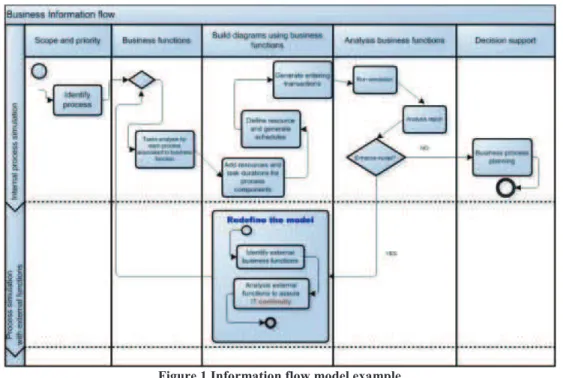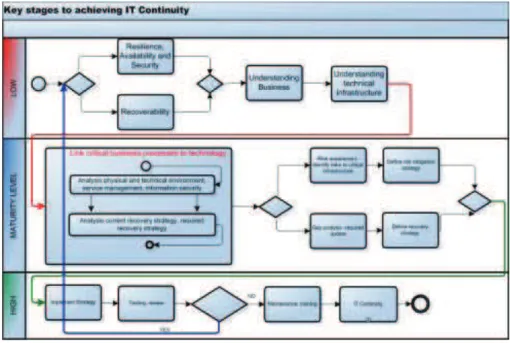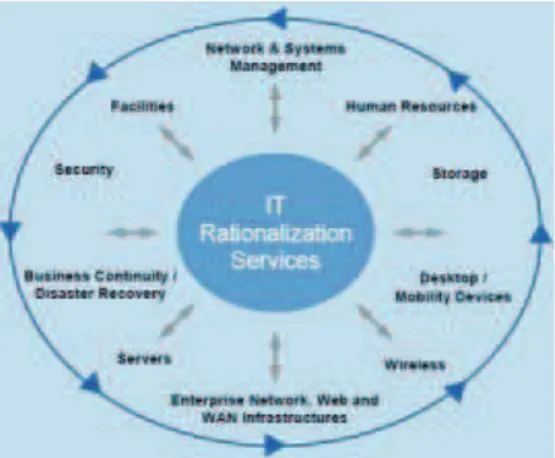INFORMATION FLOW ASSURED BY IT&C CONTINUITY PLANNING
Băbeanu Delia
Academy of Economic Studies Faculty of Accounting and Management Information Systems Piata Romana nr 6 Bucharest delia.del@gmail.com tel:0726175137
Cozgarea Gabriel
Academy of Economic Studies Faculty of Accounting and Management Information Systems Piata Romana nr 6 Bucharest cozgarea@hotmail.com tel:0745928544
Pugna Irina Bogdana
Academy of Economic Studies Faculty of Accounting and Management Information Systems Piata Romana nr 6 Bucharest irina_bogdana@yahoo.com tel : 0742483841
Gavrilă Alexandru Adrian
Academy of Economic Studies Faculty of Accounting and Management Information Systems Piata Romana nr 6 Bucharest alexgavrila@gmail.com tel:0721830787
Forwarding the frequent usage of complex processes and the big volume of information, it is imperative to manage the automatic circuit of the document flow in a company activity. The main advantage of such a system consist in document waiting to be process in a specific order and the evidence is more strict than the classic one, where loss of information or hard finding can lead to later reports of the processes results. On the other way, the big volume of information found on paper support lead of temporary or permanent work incapacity of activities department by activity blocking (lack of personnel, lack of automatic tools). A major advantage is the electronic information archives and type of restarting processes on another management system using these documents, by reducing dead time appeared in classic process.
Keywords: information flow, IT&C continuity, maturity model for IT&C continuity, IT rationalization
JEL Code: M15
Introduction
At the entity level, an important objective to apply is preparing, planning, implementing and maintenance providing continuous information systems and services in maximum security. One of the key components in maintaining continuous IT services is to identify weaknesses within the physical Information Technology and Communications (ITC) environment and infrastructure and managing these to an acceptable level of risk. Once the various threats to the service have been identified consideration can be given to any mitigation or improvements and organization may wish to implement. But, first of all, it must be define the information flow regarding business processes. So, the research is oriented on two components such as: first part has the basic concepts in information flow conducting to a model and the second part is proposing the IT rationalization presenting the implications of services (by internet technology revolution) in economic growth through security conditions.
1. Information flow model
The benefits to build an information flow model are major. First is to understand an information flow which provides logical documentation for the business process and the second is to present perspective for adding value through the types of analytical processing. A third benefit of the business modeling process is approaching user requirements to the implementation team. If any framework is used to describe a process, it not only eases the translation of user needs into system requirements, but also provides the manager how control migrates throughout the system and how information flows through the system – both of which, in turn, help guide the dissection of the problem into implementable components.
The model will take on two aspects – the flow of information into the data mart from its suppliers and the flow of information from the data mart to its users. The first flow is an operational flow, where data sets may be extracted and moved into a staging area where those data sets move through different processing stages. Despite the business intelligence aspect of the users' interactions, the information flow between the data mart clients may likely resemble a transactional information flow, with multiple analysts executing sequences of queries.
An information flow, as part of a business process model, provides the next benefits:
Designing Road Map for internal basic functions of the business: As tracking development against the original requirements, it is identifying the useful information to development of interfacing between the executions components.
Return on Investment Calculation: Allows the manager to track use of information, the amount of value-adding processing required and the amount of error prevention and correction required adding value. In this case, the manager relates the eventual business value back to the costs associated with generating that business value558. Information flow model is used when the organization need to know how information flows around, into and out of the business. This shows how information flows work between business functions (within the business) and between business and external functions (as entities like suppliers or customers).
The stages in information flow model are presented in Figure 1. Identifying the business functions must be done for which the flow of information needs to be modeled. All business functions will come from the portfolio function and should be elementary business functions.
Identifying and showing the information required by the function and where it comes from the source will be another business function or an external one. If the model must be enhancing, it is recommended to refine all the business functions, but in accordance with external functions, correlated by process type.
Feedback must reply the information flow model to the business to ensure that they are correct.
Figure 1 Information flow model example
(Update the source: http://www.onemindmanagement.com)
In case that the information is processing by distance through network technologies (internet/intranet by remote control, VPN, tunneling) the information flow system automatically managed must be compatible with network, by access levels, for specific user groups559. The system will contain workflow management and document management for an organization and offer solutions optimization for the next problems:
- Information report regarding to an activity in a user session work;
- Users e-mail announce, without creating spam’s e-mail, regarding work execution terms; - Procedures and methods to elaborate an electronic work for users’ liability;
- Flexibility and easy usage;
- Documents sending to other departments or customers/suppliers; - Recognizing information formats;
- Leading work process;
- Electronic signature acceptance;
- Individual or group warning for modifies work conditions.
Such a system must be adapted to business request for the company that is using it and it is very easy to integrate by tools choosing. An example is the documents „Portfolio” that has a very well establishes circuit for documents signing.
558 The Business Value of Information Flow Modeling, Knowledge Integrity, David Loshin, Information Management Magazine, May 1, 2003, http://www.information-management.com/issues/20030501/6630-1.html
The information system must show quickly report for document flow journal which may be named „cover sheet for information flow” and sometimes is more efficient in solve particular cases, such as contract disputed issue, by finding information needed.
To assure the stability of the information system there must be implement a continuity model for IT&C. The methodology for the model is built around six key principles (Figure 2) and implement in a maturity model for information technology continuity:
- Protecting the ITC environment is critical to maintaining the desired levels of availability for an organization. The services are at threat from environmental failures, hardware failures, operational errors, and malicious attack.
- Detecting incidents at the earliest opportunity will minimize the impact to services, reduce the recovery effort, and preserve the quality of service.
- Reacting to an incident in the most appropriate manner will enable an efficient recovery and keep any downtime to a minimum. Reacting poorly may result in a minor incident escalating into something more serious.
Figure 2 Maturity model for IT continuity (Update the source: www.siemens.co.uk)
- Recovery of services should be performed in a controlled and predetermined fashion. Identifying and implementing the appropriate recovery strategy will ensure the timely resumption of services and maintain the quality of data.
- Resume. Understanding the recovery priorities as well as the recovery point and recovery time objectives allows the most critical services to be reinstated first. Services of a less critical nature may be reinstated at a later time or in some circumstances not at all.
- Return. The process of returning from disaster mode to normal operations is often neglected by organizations. All IT Continuity plans should have an exit strategy that allows them to vacate their ITC disaster recovery centre when the time comes.
The maturity model must have six service elements that will assist an organization progress through the maturity model and achieve IT Continuity. These elements are shown in Figure 3.
Figure 3 Services address by methodology principles
2. Proposing the IT Rationalization
IT Rationalization focuses an organization on the services that produce the highest business value. Rationalization evaluates business needs, aligns IT services and reveals how to free valuable resources for business strategy and customer demands. From rationalization, it is introduced dynamically pooled resources that create flexibility, agility and the ability to respond to rapid change, eliminating everything that can stand between business and customer. Through rationalization there are:
- Increase service value by eliminating low value services and those that detract from the performance of higher value services.
- Improve operational flexibility by leveraging high value services in a shared environment to benefit other business areas.
- Simplify by eliminating one-off services and introducing common standards.
IT Rationalization Services focus on the development that specifically addresses client’s business challenges, including:
- Pressures to lower costs while improving service delivery through the introduction of standards; - Adapting to changing business strategies and models;
- Adherence to regulatory obligations imposed on business;
- Incorporating innovative technologies in IT infrastructure to create business value; - Focusing on competencies and positioning the enterprise for the future560.
IT organizations have to optimize the business value of technology. Technology executives understand the need to standardize and rationalize disparate, redundant, or obsolete applications that are accumulated over the years through evolution, acquisition or business unit autonomy. However, rationalizing the portfolio without a clear framework can increase the risk of jeopardizing the current or future IT capabilities. By rationalization it will be dramatic cost savings through streamlined IT portfolio, optimized efficiencies by elimination of redundancy, waste, and clutter. Also, increased productivity through greater standardization and less complexity is a key component of the rationalization. Bottom line business impact by creating new “product lines” more effectively is the feedback for rationalization561.
Figure 4 IT Rationalization
(source: http://www.itsolutions.siemens.com/b2b/it/en/us/Documents/publications/itr_dco_PDF_e.pdf)
Rationalization sets the stage and virtualization ushers in the significant savings, sharing technology across business units and eliminating unnecessary or redundant hardware assets. Virtualization frees applications and data from specific hardware platforms, optimizing use of computing resources throughout the enterprise.
There are many virtualization technologies now able to dynamically provide resources in a matter of hours versus days or even weeks – reliably and with greater control. These technologies make infrastructure components more accessible to a broader set of applications. Resources are no longer dedicated to a single application, but become available based on utilization and capacity562.
CONCLUSIONS
The maturity model for IT continuity must contain the information flow of the company to recover the data and information in disaster cases. Thus it must be prove experience in developing and implementing resilience, availability, security, and recovery strategies. Benchmarking is relying on IT Continuity Maturity against industry
560 https://www.it-solutions.siemens.com/b2b/it/en/us/Documents/publications/it-rationalization-transformation-services_PDF_e.pdf 561 Source: http://www.virtusa.com/services/portofolio-rationalization.asp
best practices and assurance that the strategy meets organizational needs. Modular approach allows selecting the service elements that match individual needs.
Confidence that organization can survive an incident or disaster must be implementing in information flow. Comprehensive training is also imperative to assure IT continuity.
In addition, IT rationalization services meet unique business needs. IT Rationalization focuses on streamlining and optimizing processes, while reducing complexity across entire IT environment.
REFERENCES
1. http://www.enisa.europa.eu/rmra/rm_process_02.html#01
Enterprise architecture and integration, authors Wing Hong Lam, Venky Shankararaman, Idea Group Inc (IGI) Publishing House, 2007, ISBN 1591408873;
2. http://www.eastronsrl.com
3. Siemens IT Solutions and Services, Inc., www.usa.siemens.com/it-solutions
4. The Business Value of Information Flow Modeling, Knowledge Integrity, David Loshin, 5. Information Management Magazine, May 1, 2003,
6. http://www.information-management.com/issues/20030501/6630-1.html 7. www.itsolutions.siemens.cz/files/documents
8. http://www.da.ks.gov/search/default.asp 9. http://www.onemindmanagement.com/


